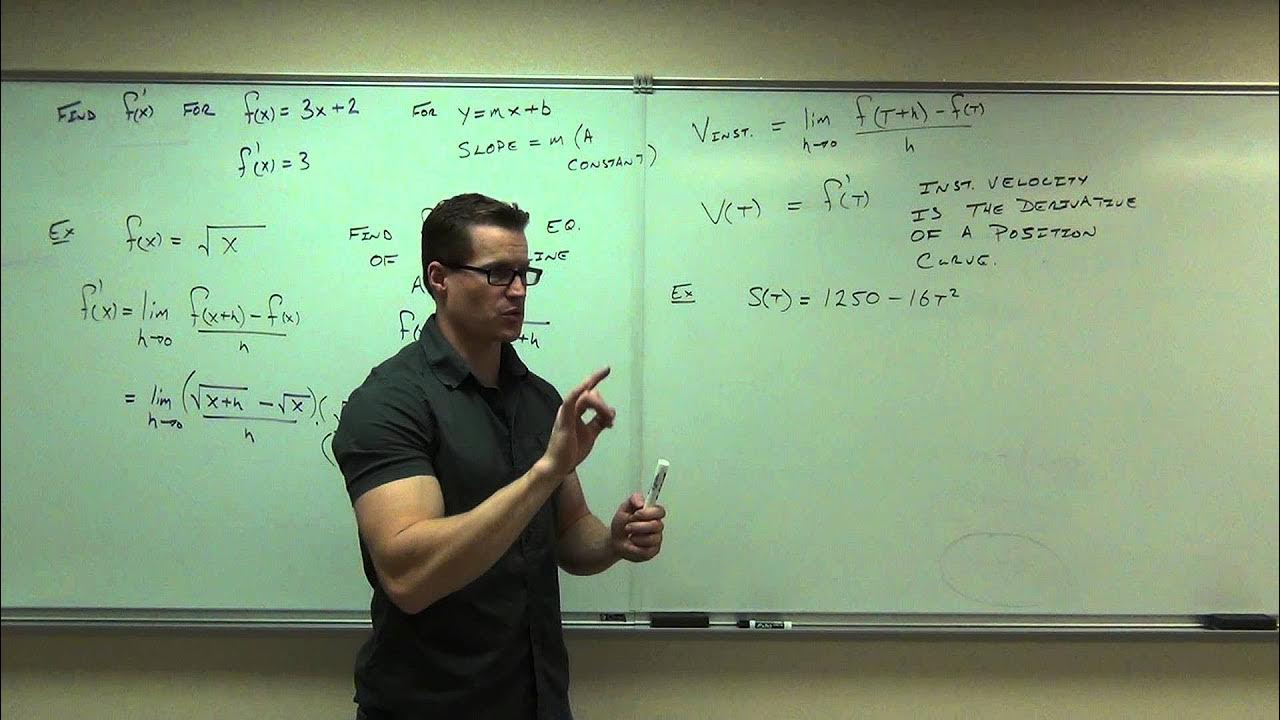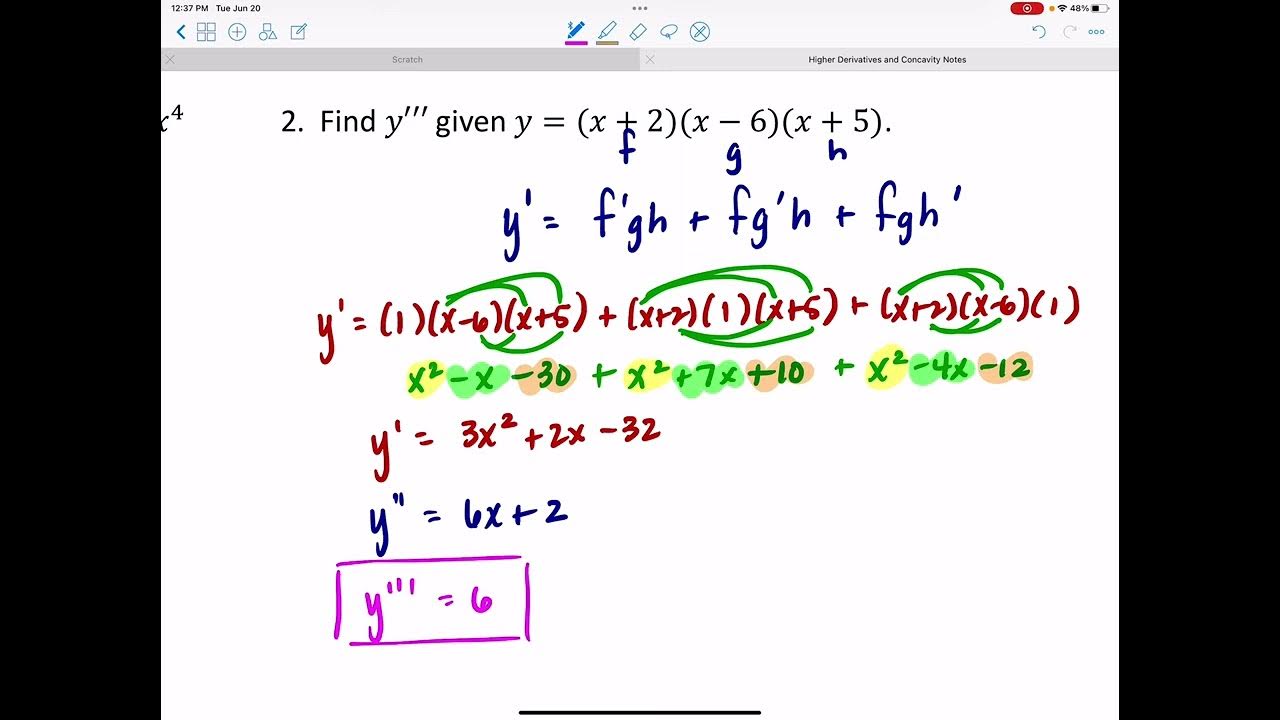AP Calculus AB Crash Course Day 1 - Differentiation
TLDRThe video script is an in-depth exploration of calculus concepts, focusing on derivatives and their applications. It begins with a step-by-step derivation of a complex exponential function, emphasizing the use of logarithmic differentiation and the power rule. The script then delves into the analysis of a function's behavior over an interval, discussing limits, domain of derivatives, and the sign of the derivative in relation to the function's direction of travel. A geometric interpretation of derivatives is presented through the calculation of the slope of a tangent line to a curve at a given point. The concept of higher-order derivatives is introduced with a pattern observed in the differentiation of an exponential function. The script also addresses the determination of when two particles move in opposite directions by comparing their velocity derivatives. Finally, the piecewise function for acceleration is derived from a given velocity function, highlighting the non-differentiability at sharp edges. This comprehensive script serves as an educational resource for understanding calculus, particularly the application of derivatives in various scenarios.
Takeaways
- 📐 The derivative of e^5 is zero because e^5 is a constant.
- 🗒️ To rewrite 1 / sqrt[3]{x^2}, express it as x^{-\frac{2}{3}} by converting the cube root to a negative exponent.
- 🔑 The power rule states that the derivative of x^n is n \cdot x^{n-1}.
- 🔍 The derivative of a^x (where a is a constant) is a^x \cdot ln(a).
- 🧮 Logarithmic differentiation can be used to find the derivative of a^x by taking the natural log of both sides and differentiating.
- 📉 The function k is differentiable on open intervals excluding points of discontinuity or sharp edges.
- 🚍 The velocity of a bus can be modeled by a piecewise function, and its acceleration is the derivative of the velocity function.
- 🔄 The slope of the tangent line to a curve at a given point is found by differentiating the equation of the curve and substituting the point's coordinates.
- ⏱️ To find when two particles are moving in opposite directions, compare their velocity derivatives over a given time interval.
- 📈 The sign of the first derivative indicates whether a function is increasing or decreasing, while the sign of the second derivative indicates concavity.
- 🛑 At points of non-differentiability, such as sharp edges or discontinuities, the derivative does not exist.
Q & A
What is the derivative of e^5 with respect to x?
-The derivative of e^5 with respect to x is 0 because e^5 is a constant, and the derivative of a constant is always zero.
How do you express 1 over the cube root of x squared in terms of x raised to a power?
-You can express 1 over the cube root of x squared as x to the power of -2/3. This is derived by taking the cube root (1/3 power) and squaring it to get (1/3)^2 = 1/9, and then taking the reciprocal to get -2/3.
What is the rule for differentiating a^x, where a is a constant and x is the variable?
-The derivative of a^x with respect to x is a^x times the natural logarithm of a, or a^x * ln(a).
How can you use logarithmic differentiation to find the derivative of 11^x?
-You can set y = 11^x, take the natural logarithm of both sides to get ln(y) = x * ln(11), then differentiate implicitly with respect to x to find dy/dx = y * ln(11), which simplifies to dy/dx = 11^x * ln(11).
What is the condition for the limit of a function to exist at a certain point?
-The limit of a function exists at a certain point if the left-hand limit and the right-hand limit at that point are equal.
At which points is the function k not differentiable?
-The function k is not differentiable at points where there are sharp edges or discontinuities. In the given script, k is not differentiable at points c and d.
How can you determine the intervals where two particles are moving in opposite directions?
-To determine the intervals where two particles are moving in opposite directions, you would find the intervals where the signs of their derivatives (velocities) are different. If one derivative is positive and the other is negative in a given interval, the particles are moving in opposite directions.
What is the slope of the tangent line to the curve x^5 - x^3 * y^4 = 10 at the point (-2, -1)?
-The slope of the tangent line at the point (-2, -1) is found by substituting x = -2 and y = -1 into the derivative of the curve's equation. After simplification, the slope dy/dx is found to be -13/42.
At which point(s) is the first derivative of a function negative and the second derivative positive?
-The first derivative is negative where the function is decreasing, and the second derivative is positive where the function is concave up. So, the function is at point p where it is decreasing and concave up.
What is the pattern for the nth derivative of e^(kx)?
-The nth derivative of e^(kx) is k^n * e^(kx). This pattern is observed by repeatedly differentiating e^(kx) and applying the chain rule.
How do you determine the times when two particles are traveling in opposite directions based on their position functions?
-You would take the derivatives of the position functions to get the velocity functions. Then, you would find the critical points (where the velocity is zero or undefined) and test intervals between these points to determine where the velocity of one particle is positive and the other is negative, indicating they are traveling in opposite directions.
How do you write a piecewise-defined function for the acceleration of a bus given its velocity function?
-The acceleration function is the derivative of the velocity function. For each linear segment of the velocity function graph, you calculate the slope (which represents the acceleration) and define the acceleration function piecewise with these slopes. At points where there are sharp edges in the velocity graph, the acceleration is undefined.
Outlines
📝 Derivative of Composite Functions
This paragraph explains the process of finding the derivative of a composite function involving exponential and power functions. The explanation includes rewriting the second term, applying the power rule, and using logarithmic differentiation to find the derivative of 11 to the power of x. It also covers simplifying the derivative and understanding the concept of limits and differentiability of a function k on an open interval.
🔍 Implicit Differentiation and Slope of Tangent Line
The second paragraph delves into implicit differentiation, specifically applied to an equation involving x and y to the power of five and four. It demonstrates the product rule and chain rule for differentiation, substitutes a given point into the derivative to find the slope of the tangent line, and discusses the conditions for the first and second derivatives to determine the concavity and points where the function is increasing or decreasing.
🚀 Particle Motion and Direction of Travel
This section focuses on determining the times when two particles are moving in opposite directions. It involves finding the derivatives of the position functions of the particles, setting them equal to zero to find stopping points, and using sign charts to analyze the intervals where the particles' velocities have opposite signs, indicating they are moving in opposite directions.
🚌 Bus Acceleration as a Piecewise Function
The final paragraph describes how to model the acceleration of a bus over time using a piecewise function. It involves finding the derivative of the bus's velocity function, identifying the slopes of the line segments in the velocity graph, and noting that the acceleration function is not defined at certain points due to sharp edges in the velocity graph, which indicate non-differentiability.
Mindmap
Keywords
💡Derivative
💡Power Rule
💡Logarithmic Differentiation
💡Chain Rule
💡Limit
💡Domain
💡Product Rule
💡Tangent Line
💡Concavity
💡Acceleration
💡Piecewise Function
Highlights
Rewriting the expression 1 over the cube root of x squared as x to the negative 2 thirds simplifies the derivative calculation.
The derivative of e to the fifth is zero because it is a constant.
Using the power rule to find the derivative of x to the negative two thirds.
Derivative of 11 to the x is found using the rule that involves the natural logarithm of the base.
Logarithmic differentiation is introduced as an alternative method for finding derivatives.
Limit as x approaches c exists if left and right-hand limits are equal, demonstrated on the graph of function k.
The domain of the derivative of k excludes points of discontinuity and sharp edges.
The derivative of k is negative on the interval db, indicating the function is decreasing in that interval.
Differentiating both sides of an equation involving x and y using product rule and chain rule.
Substituting specific values into the derivative to find the slope of a tangent line.
Identifying points where the first derivative is negative and the second derivative is positive to determine concavity.
Derivatives of e to the kx follow a pattern where the nth derivative is k to the n times e to the kx.
Determining when two particles move in opposite directions by comparing their derivative signs over time intervals.
Using a sign chart to analyze the direction of particle movement based on the sign of their derivatives.
A piecewise-defined function for a bus's acceleration is created from the velocity function's graph.
Sharp edges in a graph indicate points of non-differentiability, which are excluded from the domain of the derivative.
The slope of line segments in a graph represents the acceleration at different time intervals for the bus's velocity.
Transcripts
Browse More Related Video

AP Calculus AB Crash Course Day 3 - Limits, Continuity, and Differentiation

Calculus 1 Lecture 2.1: Introduction to the Derivative of a Function

1.8 - Higher Order Derivatives

Higher Derivatives and Concavity

Calculus - Lesson 11 | Derivative as a Function | Don't Memorise

Business Calculus - Math 1329 - Section 4.3 - Derivatives of Exponential and Logarithmic Functions
5.0 / 5 (0 votes)
Thanks for rating: